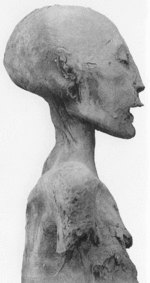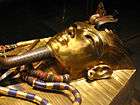The Younger Lady

The Younger Lady is the informal name given to a mummy discovered in the Egyptian Valley of the Kings, in tomb KV35 by archeologist Victor Loret in 1898.[1] Through recent DNA tests this mummy has been identified as the mother of the Pharaoh Tutankhamun, and a daughter of Pharaoh Amenhotep III and Queen Tiye. The mummy also has been given the designation KV35YL ("YL" for "Younger Lady") and 61072,[2] and currently resides in the Egyptian Museum in Cairo. Early speculation was that this mummy was the remains of Queen Nefertiti, which remains plausible, but DNA testing has not confirmed this and questions about that possibility remain.[3][4]
Discovery and identification
The mummy was found adjacent to two other mummies in KV35: a young boy who died at around the age of 10, thought to be Webensenu, and another, older woman, identified as Queen Tiye by the recent DNA studies on Tutankhamun's lineage.[5] All were found together, lying naked side-by-side and unidentified in a small antechamber of the tomb. All three mummies had been extensively damaged by ancient tomb robbers.
There has been much speculation as to the identity of the Younger Lady mummy. Upon finding the mummy, Victor Loret initially had believed it be that of a young man as the mummy's head had been shaved. A closer inspection later made by Dr. Grafton Elliot Smith confirmed that the mummy was that of a female, although Loret's original interpretation persisted for many years.

Recently, autosomal and mitochondrial DNA testing have shown conclusively that the mummy is that of a female and, that she was the mother of Tutankhamun.[5] The results also show that she was a full-sister to her husband, the mummy from KV55, and that they were both the children of Amenhotep III and Queen Tiye.[5] There is speculation over the identity of the mummy from KV55 (sister marriage existed), with some Egyptologists, including Zahi Hawass, claiming the mummy is Akhenaten, and others, including anthropologist Joyce Filer, claiming the mummy as Smenkhare. This family relationship would lessen the possibility that the Younger Lady (and, by extension, Tutankhamun's mother) was either Nefertiti, or Akhenaten's secondary wife Kiya, because no known artifact accords either wife titles such as "King's sister" or "King's Daughter".[6] The possibility of the younger lady being Sitamun, Isis, or Henuttaneb is considered unlikely, as they were Great Royal Wives of their father Amenhotep III, and had Akhenaten married any of them, they would have taken the place of Nefertiti as the principal queen of Egypt. The report concludes that the mummy is likely to be Nebetah or Beketaten, daughters of Amenhotep III not known to have married their father, although he is known to have had eight daughters with Queen Tiye.[6](Comment: Figure 2 eAppendix)
There is also a theory that the younger lady is Meritaten, daughter of Akhenaten and Nefertiti, and wife of Smenkhare, based on a study of the alleles inherited by Tutankhamun. The theory goes that Meritaten married Smenkhare, believed to be her uncle, and thereby making Tutankhamun a maternal grandson of Akhenaten. The theory holds weight as inbreeding makes it harder to distinguish the generations, but there is one problem with this theory. Meritaten must be a mitochondrial descendant of Queen Tiye, or her mother Thuya, as the younger lady's mitochondrial DNA fits with her being Tiye's daughter. Nefertiti's lineage is nowhere specified, and if Meritaten is the younger lady, Nefertiti must be a mitochondrial relation of Thuya.
It has been suggested that, indeed, the Younger Lady is Nefertiti, as incest was not uncommon. This would mean that Akhenaten did marry his own sister and that he and Nefertiti are the parents of Tutankhamun. Furthermore, Nefertiti, who may have survived her husband, may be identical with Smenkhare and may have adopted this name if she took over the reign after Akhenaten's death (and having her daughter move into her official roles of chief priestess and 'wife'). All this is not proven, but should be mentioned as a further plausible scenario.[7] One difficulty posed by this identification is the mummy's age at death, because Nefertiti gave birth to Meritaten no later than year 1 of Akhenaten's reign and there is evidence that she was still alive during year 16.
Description of the mummy

Grafton Elliot Smith provided an extensive description of the mummy in his survey of the ancient royal mummies at the beginning of the twentieth century. He found the mummy to be 1.58 m (5 ft 2 in) in height, and judged her to have been no older than 25 years old at the time of death.[8] He also noted the major damage done by ancient tomb robbers, who smashed the anterior wall of the mummy's chest, and had torn the right arm off just below the shoulder.[9] Smith presumed that she was a member of the royal family.[9]
It had been thought that the large wound in the left side of the mummy's mouth and cheek, which also destroyed part of the jaw, had been the result of actions of the tomb robbers,[9] but a more recent re-examination of the mummy while it was undergoing genetic tests and CT scans determined that the wound had happened prior to death and that the injury had been lethal.[6]
References
- ↑ Reeves, Nicholas. Wilkinson, Richard H. The Complete Valley of the Kings. p100. Thames & Hudson. 1997. (Reprint) ISBN 0-500-05080-5
- ↑ Smith, G. Eliot. The Royal Mummies p.117 Duckworth Publishers, 2000
- ↑ Hawass Z; Gad YZ; Ismail S; et al. (2010-02-17). "ANcestry and pathology in king tutankhamun's family". JAMA. 303 (7): 638–647. doi:10.1001/jama.2010.121. ISSN 0098-7484.
- ↑ "King Tut's Family Secrets - National Geographic Magazine". ngm.nationalgeographic.com. Retrieved 2016-09-21.
- 1 2 3 Hawass Z, Gad YZ, Ismail S, Khairat R, Fathalla D, Hasan N, Ahmed A, Elleithy H, Ball M, Gaballah F, Wasef S, Fateen M, Amer H, Gostner P, Selim A, Zink A, Pusch CM (February 2010). "Ancestry and Pathology in King Tutankhamun's Family". JAMA. 303 (7): 638–47. doi:10.1001/jama.2010.121. PMID 20159872.
- 1 2 3 Hawass Z, et al. "Ancestry and pathology in King Tutankhamun's family". JAMA. 2010;303(7):eAppendix p.3.
- ↑ Michael E. Habicht, Nofretete und Echnaton, 2012, Koehler & Amelang, ISBN 978-3733803810
- ↑ Smith, G. Elliot. The Royal Mummies. p.40. Duckworth Egyptology. 2000 (Reprint from original 1912 edition). ISBN 0-7156-2959-X
- 1 2 3 Smith, G. Elliot. The Royal Mummies. p.41. Duckworth Egyptology. 2000 (Reprint from original 1912 edition). ISBN 0-7156-2959-X
External links
| Wikimedia Commons has media related to The Younger Lady (mummy). |
